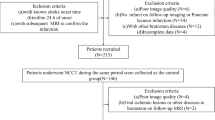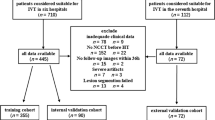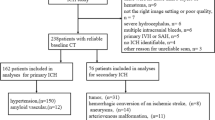Abstract
Objective
The performance and stability of radiomics model caused by dimension reduction remain being confronted with major challenges. In this study, we aimed to propose a new scheme of global feature management independent of dimension reduction to improve it.
Methods
The non-contrast computed tomography (NCCT) images of acute brainstem infarction (ABI) from two medical centers were used as test and validation sets. A new scheme was constructed based on global feature management, and the traditional scheme dependent on dimension reduction was used as control. The radiomic features of NCCT images were extracted in Matlab R2013a. The performance of prediction model was evaluated by the generalized linear model (GLM) and multivariate logistic regression. And, the stability of radiomics model was evaluated with the difference of area under curve (AUC) between the test and validation sets.
Results
Compared with the traditional scheme, the new scheme presented a similar detection performance (AUC: 0.875 vs. 0.883), yet a better performance in predicting prognosis (AUC: 0.864, OR = 0.917, p = 0.021 vs. AUC:0.806, OR = 0.972, p = 0.007). All these results were well verified in an independent validation set. Moreover, the new scheme showed stronger stability in both the detection model (ΔAUC: 0.013 vs. 0.039) and prediction model (ΔAUC = 0.004 vs. 0.044).
Conclusion
Although there might be several limitations, this study proved that the scheme of global feature management independent of dimension reduction could be a powerful supplement to the radiomics methodology.
Key Points
• The new scheme (S wavelet ) presented similar detection performances for ABI with the traditional scheme.
• A better predictive performance for END was found in the new scheme (S wavelet ) compared with the traditional scheme.
• Stronger model stability was found in both the detection and prediction models based on the new scheme.





Similar content being viewed by others
Abbreviations
- ABI:
-
Acute brainstem infarction
- CTP:
-
Computer tomography perfusion
- END:
-
Early neurological deterioration
- GLM:
-
Generalized linear model
- HCs:
-
Healthy controls
- MRI:
-
Magnetic resonance imaging
- NCCT:
-
Non-contrast computed tomography
- NIHSS:
-
National Institute of Health Stroke Scale
- PCA:
-
Principal component analysis
- RMC:
-
Regional Medical Consortium
- ROI:
-
Regions of interest
References
Lambin P, Leijenaar R, Deist T et al (2017) Radiomics: the bridge between medical imaging and personalized medicine. Nat Rev Clin Oncol 14:749–762
Mayerhoefer M, Materka A, Langs G et al (2020) Introduction to radiomics. J Nucl Med: official publication, Society of Nuclear Medicine 61:488–495
van Griethuysen J, Fedorov A, Parmar C et al (2017) Computational radiomics system to decode the radiographic phenotype. Cancer Res 77:e104–e107
Kang D, Park J, Kim Y et al (2018) Diffusion radiomics as a diagnostic model for atypical manifestation of primary central nervous system lymphoma: development and multicenter external validation. Neuro Oncol 20:1251–1261
Huang Y, Liang C, He L et al (2016) Development and validation of a radiomics nomogram for preoperative prediction of lymph node metastasis in colorectal cancer. J Clin Oncol 34:2157–2164
Xu L, Yang P, Liang W et al (2019) A radiomics approach based on support vector machine using MR images for preoperative lymph node status evaluation in intrahepatic cholangiocarcinoma. Theranostics 9:5374–5385
Kontos D, Ikejimba L, Bakic P, Troxel A, Conant E, Maidment A (2011) Analysis of parenchymal texture with digital breast tomosynthesis: comparison with digital mammography and implications for cancer risk assessment. Radiology 261:80–91
Rondina J, Hahn T, de Oliveira L et al (2014) SCoRS--a method based on stability for feature selection and mapping inneuroimaging [corrected]. IEEE Trans Med Imaging 33:85–98
Parmar C, Grossmann P, Bussink J, Lambin P, Aerts H (2015) Machine learning methods for quantitative radiomic biomarkers. Sci Rep 5:13087
Ayesha S, Hanif MK, Talib R (2020) Overview and comparative study of dimensionality reduction techniques for high dimensional data. Inf Fusion 59:44–58
Berberich A, Schneider C, Reiff T, Gumbinger C, Ringleb P (2019) Dual antiplatelet therapy improves functional outcome in patients with progressive lacunar strokes. Stroke 50:1007–1009
Aerts H, Velazquez E, Leijenaar R et al (2014) Decoding tumour phenotype by noninvasive imaging using a quantitative radiomics approach. Nat Commun 5:4006
Galili T (2015) dendextend: an R package for visualizing, adjusting and comparing trees of hierarchical clustering. Bioinformatics 31:3718–3720
Meyer M, Ronald J, Vernuccio F et al (2019) Reproducibility of CT radiomic features within the same patient: influence of radiation dose and CT reconstruction settings. Radiology 293:583–591
Lambin P, Rios-Velazquez E, Leijenaar R et al (2012) Radiomics: extracting more information from medical images using advanced feature analysis. Eur J Cancer 48:441–446
Wei J, Jiang H, Gu D et al (2020) Radiomics in liver diseases: current progress and future opportunities. Liver Int 40:2050–2063
Weiner M, Veitch D, Aisen P et al (2015) 2014 update of the Alzheimer's Disease Neuroimaging Initiative: a review of papers published since its inception. Alzheimers Dement 11:e1–e120
Baessler B, Mannil M, Oebel S, Maintz D, Alkadhi H, Manka R (2018) Subacute and chronic left ventricular myocardial scar: accuracy of texture analysis on nonenhanced cine MR images. Radiology 286:103–112
Fain S (2019) Machine learning reveals the texture of regional lung ventilation at CT. Radiology 293:685–686
Truhn D, Schrading S, Haarburger C, Schneider H, Merhof D, Kuhl C (2019) Radiomic versus convolutional neural networks analysis for classification of contrast-enhancing lesions at multiparametric breast MRI. Radiology 290:290–297
Lin Y, Zhang L, Bao J et al (2014) Risk factors and etiological subtype analysis of brainstem infarctions. J Neurol Sci 338:118–121
Schellinger P, Fiebach J, Hacke W (2003) Imaging-based decision making in thrombolytic therapy for ischemic stroke: present status. Stroke 34:575–583
Kazmierczak P, Dührsen M, Forbrig R et al (2020) Ultrafast brain magnetic resonance imaging in acute neurological emergencies: diagnostic accuracy and impact on patient management. Invest Radiol 55:181–189
Runge V, Richter J, Heverhagen J (2017) Speed in clinical magnetic resonance. Invest Radiol 52:1–17
Gomolka R, Chrzan R, Urbanik A, Nowinski W (2016) A quantitative method using head noncontrast CT scans to detect hyperacute nonvisible ischemic changes in patients with stroke. J Neuroimaging 26:581–587
Srivatsan A, Christensen S, Lansberg M (2019) A relative noncontrast CT map to detect early ischemic changes in acute stroke. J Neuroimaging 29:182–186
Acknowledgements
The authors disclosed receipt of the following financial support for the research, authorship, and publication of this article.
Funding
This work was supported by National Natural Science Foundation of China (81871343); Jiangsu Provincial Key Research and Development Plan (BE2021693).
Author information
Authors and Affiliations
Corresponding authors
Ethics declarations
Guarantor
The scientific guarantor of this publication is Shenghong Ju.
Conflict of interest
The authors of this manuscript declare no relationships with any companies whose products or services may be related to the subject matter of the article.
Statistics and biometry
No complex statistical methods were necessary for this paper.
Informed consent
Written informed consent was obtained from all subjects (patients) in this study.
Ethical approval
Institutional Review Board approval was obtained.
Methodology
• prospective
• predictive study
• performed at multi-institutions (multi-center data)
Additional information
Publisher’s note
Springer Nature remains neutral with regard to jurisdictional claims in published maps and institutional affiliations.
Supplementary Information
ESM 1
(DOCX 1556 kb)
Rights and permissions
About this article
Cite this article
Li, Y., Xie, Y., Xu, Y. et al. A new scheme of global feature management improved the performance and stability of radiomics model: a study based on CT images of acute brainstem infarction. Eur Radiol 32, 5508–5516 (2022). https://doi.org/10.1007/s00330-022-08659-w
Received:
Revised:
Accepted:
Published:
Issue Date:
DOI: https://doi.org/10.1007/s00330-022-08659-w




